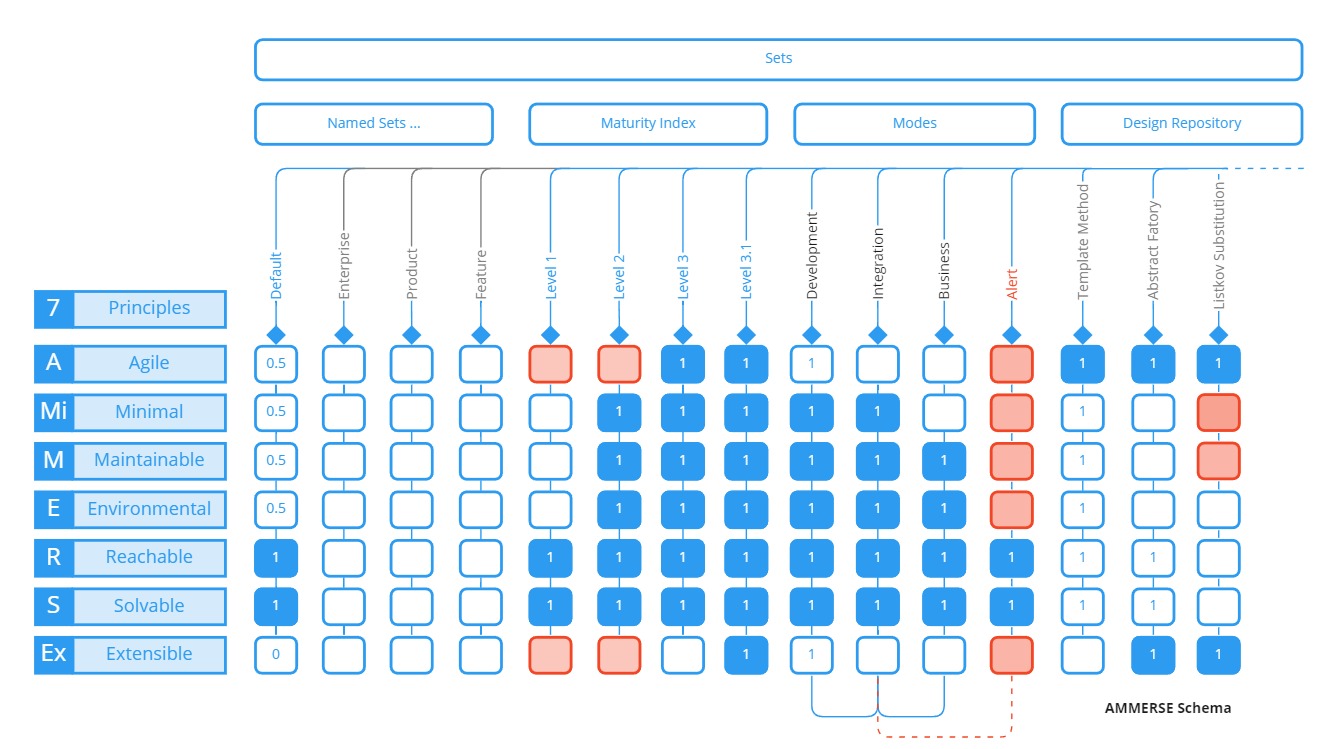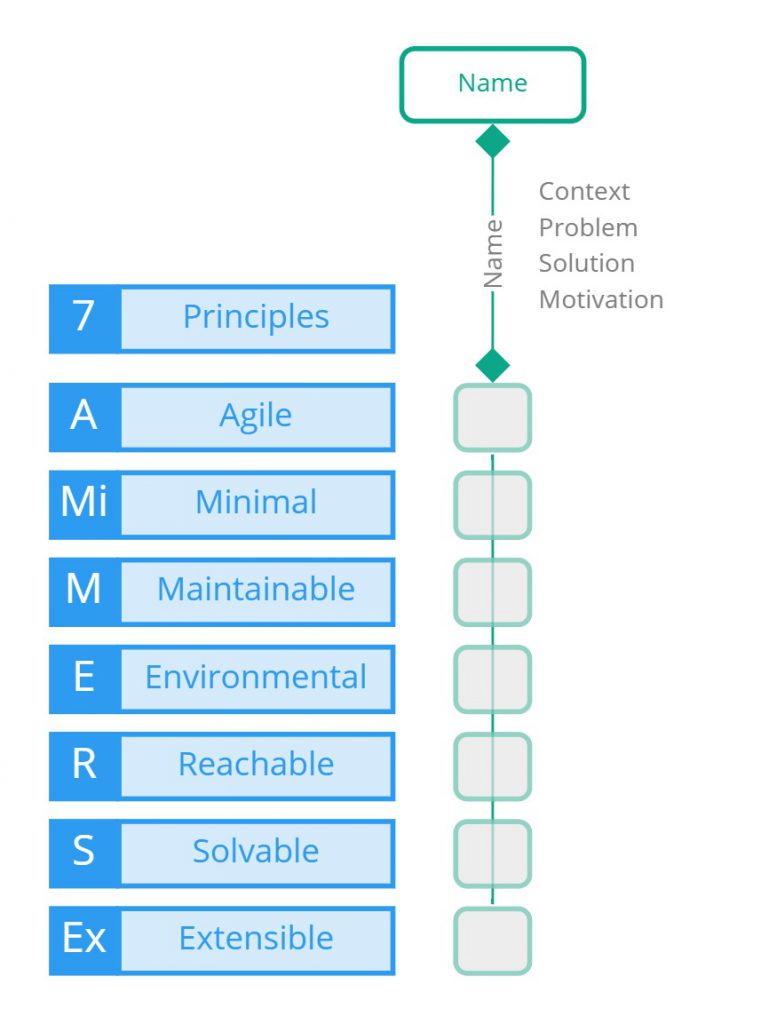At the core of AMMERSE are the seven values. These values are the interrelated elements that make up a system. When you evaluate a system, you can see these values and discover/plan their synergy. Their configuration provide context and understanding. The seven values are principles, elements in the system, categories in an ontology and even a mental model of a system. It is a means of reasoning about vision, strategy, measurements, gaps, categories, processes and can filter everything we do in a business.
Depending on what we are considering, the word principle can change to describe its role. For example, a principle is an "element" in the system". It is a weight in a decision matrix. It is a category in categorisation. It is a value in ethics. It is a force in a synergy.
The core principles (Level 1)
The seven values are Agile (A), Minimal (Mi), Maintainable (M), Environmental (E), Reachable (R), Solvable (S) and Extensible (Ex).
Read more about why the AMMERSE language exists as A Value System, including the paper entitled An abstraction language for aligning Individual and Organisational values
Discovery
At a simplistic level, they become the right questions to ask, How agile is this? How minimal is this? They formulate the “right” questions. Can I do this within the budget (Reachable) or within a time frame (Reachable)? Can the solution be extended (Extensible).
Forces
If this is Minimal, is it also Maintainable? If it is Extensible, our Reachable and Maintainable force increases. They complement or detract from each other depending on the context. This also relates to relationships, dependencies, positive/negative feedback and synergies.
Weights
Each principle can be assigned a weight, a value from 0..1. As a weight, you can be more precise about the principles and their context. For example, “what is the current state of our process flow?” A Minimal score of 0.2 vs 0.8 could be considered based on how minimal the process is. If you can remove a step, you know it's less minimal. This is the start of an evalution.
Evaluating
Weighted principles can be assigned to various things in the business and can be compared. You can be as empirical as you wish. Care should be taken to evaluate and compare effectively. Garbage in, Garbage out applies. The idea of measuring the gap is a large part of AMMERSE.
The AMMERSE Set (Level 2)
When you add weights to all the principles for a given context and assign it a name, it becomes a named Set. For example, the current state of the website is A(0) Mi(1), M(.2), E(.5), R(1), S(0.8), E(.2), so we name it “2022 Current Site”. The next year after many changes, you evaluate it again, but this time the set is “2023 Current Site”. You can do this for any capability, design or even strategy.
As Strategy
By creating a set with a purpose, you can create an objective. Let's assume the same website needs to evolve to an Extensible offering; we can create a “2023 Website Target” Set with Ex(.8). This now reflects the desire to boost the extensibility of the site. The developers can then evaluate what the desire means to them technically. They may conclude that something should be redesigned, reworked or done to satisfy the strategy. This easily becomes a strategy, capability model and a roadmap.
As Progress
By storing and evaluating Sets, you can easily measure direction and progress towards your goal. It is important to remember that accuracy is something you need to work on, as weights need to be carefully created in the same manner each time.
AMMERSE Framework (Level 3)
You can easily construct your framework by creating Sets that correlate. AMMERSE comes with three examples; Maturity Index, Modes and Design Repository. They show how a framework can be built. You may find value in one or more of them, modify them to suit or create your own (see Extending 3.1).
Maturity Index
The Maturity Index is a built-in example framework consisting of 4 Sets, “Level 1”, “Level 2”, “Level 3”, “Level 3.1”. Level 1 = R(1), S(1). Level 2 = Mi(1), M(1), E(1), R(1), S(1) . Level 3 adds A(1), and Level 3.1 adds Ex(1). This gives you a maturity level used as a measure and or a strategy. For example, Your target could be Level 1 or Level 3, depending on your business. The Maturity Index is for all kinds of products and services. Imagine a business of M(1), R(1), S(1) vs E(1), Mi(1).
Notice that I have used the Maturity Index in the headings of this guide to show what the level is concerned with in terms of principles and maturity of their implementation.
Explanation of the Maturity Index
Modes
Modes is an example framework consisting of 4 Sets which represent modes for a team. The four sets are “Development”, “Integration”, “Business”, and a special Set called “Alert”. You can move a team from one mode to another; therefore, everyone understands the focus. You could also create three teams named after the modes and move work between them, with Alert being the synchronous activity all teams do in an emergency.
Design Repository
The Design Repository is another example framework that maps the GoF Design Patterns into the seven principles. Some patterns may appear in two or more principles. For example, the Singleton could be E(1), meaning the environment it runs in requires a single instance. A Factory Method could be considered Mi(1), M(1), but not Ex(0), whereas the Abstract Factory could be considered Mi (0), M(.5), Ex(1). If your “Strategy Set” is a Mi (1), S(1) Ex(0), you would understand which pattern would be best suited.
Extending (Level 3.1)
There are several hotspots and conventions for the extension of AMMERSE.
New Principles
It is strongly advised that new principles should not be your first thought, as it is most likely covered by the seven. It is also advised that you keep your extended principles within your organisation and that everyone understands it is not part of the core. There are rules for extending that will be published separately.
The convention is to use the first letter after an x, as in AMMERSExP where P is your new principle. This way, everyone knows it's an extension.
Named Concepts
Concepts should be added to a principle. For example, if you want to add a Lean concept, the most appropriate principle may be "Minimal" or "Maintainable".
Processes
You can create a process flow that has Sets at its core. Consider each Set to be a flow or a step. You can define rules around the process flow based on principles. If Agile (1), test-cases must exist. If Environmental, an ethics checklist is required.
Methods
An entire management method could be designed on AMMERSE. We ask that you include AMMERSE as its foundationt in the name to ensure that AMMERSE is presented. AMMERSE Maturity Index as an example.
Pattern Language
AMMERSE is built on the concept of a pattern language. This means that you must inherit from this concept. Named Sets, Frameworks built on AMMERSE should have an Intent, Solution to a Problem and presented as such. If you do not, the design, implementation and uptake of such a thing would be obscured. You will need to see the separate Pattern Langauge guide for more.



